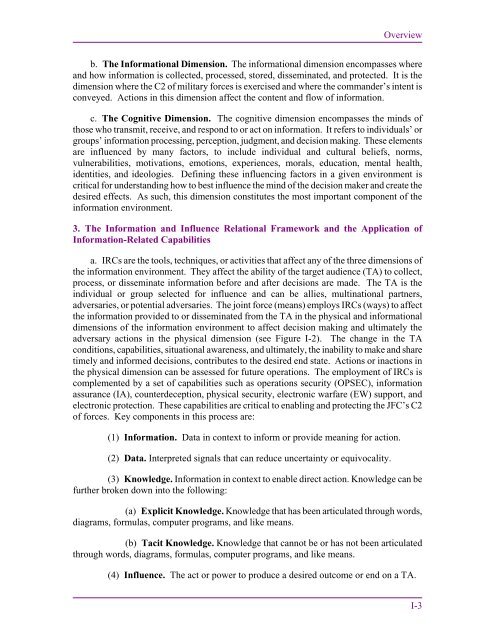JP 3-13, Information Operations - Defense Innovation Marketplace
JP 3-13, Information Operations - Defense Innovation Marketplace
JP 3-13, Information Operations - Defense Innovation Marketplace
Create successful ePaper yourself
Turn your PDF publications into a flip-book with our unique Google optimized e-Paper software.
Overview<br />
b. The <strong>Information</strong>al Dimension. The informational dimension encompasses where<br />
and how information is collected, processed, stored, disseminated, and protected. It is the<br />
dimension where the C2 of military forces is exercised and where the commander’s intent is<br />
conveyed. Actions in this dimension affect the content and flow of information.<br />
c. The Cognitive Dimension. The cognitive dimension encompasses the minds of<br />
those who transmit, receive, and respond to or act on information. It refers to individuals’ or<br />
groups’ information processing, perception, judgment, and decision making. These elements<br />
are influenced by many factors, to include individual and cultural beliefs, norms,<br />
vulnerabilities, motivations, emotions, experiences, morals, education, mental health,<br />
identities, and ideologies. Defining these influencing factors in a given environment is<br />
critical for understanding how to best influence the mind of the decision maker and create the<br />
desired effects. As such, this dimension constitutes the most important component of the<br />
information environment.<br />
3. The <strong>Information</strong> and Influence Relational Framework and the Application of<br />
<strong>Information</strong>-Related Capabilities<br />
a. IRCs are the tools, techniques, or activities that affect any of the three dimensions of<br />
the information environment. They affect the ability of the target audience (TA) to collect,<br />
process, or disseminate information before and after decisions are made. The TA is the<br />
individual or group selected for influence and can be allies, multinational partners,<br />
adversaries, or potential adversaries. The joint force (means) employs IRCs (ways) to affect<br />
the information provided to or disseminated from the TA in the physical and informational<br />
dimensions of the information environment to affect decision making and ultimately the<br />
adversary actions in the physical dimension (see Figure I-2). The change in the TA<br />
conditions, capabilities, situational awareness, and ultimately, the inability to make and share<br />
timely and informed decisions, contributes to the desired end state. Actions or inactions in<br />
the physical dimension can be assessed for future operations. The employment of IRCs is<br />
complemented by a set of capabilities such as operations security (OPSEC), information<br />
assurance (IA), counterdeception, physical security, electronic warfare (EW) support, and<br />
electronic protection. These capabilities are critical to enabling and protecting the JFC’s C2<br />
of forces. Key components in this process are:<br />
(1) <strong>Information</strong>. Data in context to inform or provide meaning for action.<br />
(2) Data. Interpreted signals that can reduce uncertainty or equivocality.<br />
(3) Knowledge. <strong>Information</strong> in context to enable direct action. Knowledge can be<br />
further broken down into the following:<br />
(a) Explicit Knowledge. Knowledge that has been articulated through words,<br />
diagrams, formulas, computer programs, and like means.<br />
(b) Tacit Knowledge. Knowledge that cannot be or has not been articulated<br />
through words, diagrams, formulas, computer programs, and like means.<br />
(4) Influence. The act or power to produce a desired outcome or end on a TA.<br />
I-3

















